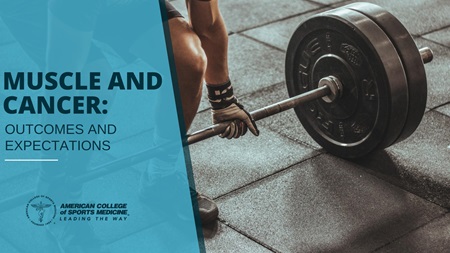Ciaran Fairman, Ph.D., CSCS, CET |
Feb.
15, 2022

Low muscle and prognosis
The question of muscle and cancer is one of the most fascinating and rapidly growing areas of exercise oncology. Dr. Carla Prado is considered one of the godmothers of this field: Her 2007 study identified low lean body mass as a predictor of chemotherapy toxicity in individuals with colon cancer. Since then, people have been really digging into relationship between low muscle and treatment toxicity/response in cancer. We’re still not entirely clear what’s going on, but our best (educated) guess, is that low muscle mass equates to a smaller tissue volume to distribute, metabolize and clear treatments such as chemotherapy. That’s not all: Low muscle at diagnosis and loss of muscle mass during treatment are both associated with a poor treatment response, an accelerated trajectory toward disability, an increased risk of comorbidities, and an increased risk of mortality.
So, if low muscle is the problem, let’s just increase it, right?
Not so fast. You’re on the right track, but I wish it was that easy! It sounds like the perfect solution, but it turns out we don’t have that much evidence to say we can reliably increase muscle mass in individuals with cancer. In fact, Dr. Briana Clifford recently published a meta-analysis that examined the effects of resistance training on body composition in cancer during and after treatment. After including 15 studies, the results indicated that resistance training interventions ranging all the way up to 12 months in duration yielded only ~0.4kg increase in lean mass. If that doesn’t sound like much to you, you’re right — particularly when you compare this to the ~1.1 kg increase in lean mass that Peterson et al. found from their meta-analysis of trials of resistance training in apparently healthy older adults. So, it seems like there is something going on that is impacting our ability to increase muscle from exercise training in cancer. The immediate next question is why?
You’re the blogger — you tell me!
Oh yes, you’re right: there’s a lot of suggestions flying around as to (1) why muscle loss is so prevalent in cancer and (2) why is it so hard to reverse. Let’s start with No. 1: We recently published a paper outlining the impact of various cancer treatments on catabolic signaling in muscle, in addition to some of behavioral/lifestyle factors that will also help answer No. 2. Essentially, various cancer treatments (e.g., chemotherapy, radiation, surgery, immunotherapy and even corticosteroids) can have a direct/indirect impact on skeletal muscle signaling, creating an imbalance in anabolic and catabolic processes that causes the muscle to start to break down. I should say this is largely dependent on the type, dose, duration, sequence and combination of treatments. Also, high-grade inflammation is thought to be a major player that also influences muscle breakdown. You could be forgiven for thinking that all we have to do is find an agent that can stop the impact of cancer treatments/inflammation on muscle signaling, and we’re home free. Well, not so fast. You see, skeletal muscle signaling is only half the battle, if that. Let’s talk about some other factors that influence muscle loss.
Beyond signaling — human beings are complex.
Not all cancer diagnoses are the same. Not all treatment regimens are the same. Not all humans are the same. All these things come together in this whirlwind that contributes to muscle loss. You could probably guess a few: inactivity (or at least reduced activity) is both understandable and common after a cancer diagnosis. If you’ve had a loved one go through cancer, you might have heard about the low energy, nausea, depression, anxiety, and pain that can often be experienced. These can contribute to inactivity but can also make it difficult to get enough calories to support the maintenance of muscle. Difficulty swallowing, dry mouth and malabsorption (depending on the tumor), can influence the ability to sustain body weight. Immunosuppression can also impact the muscle- remodeling process.
When you start to layer all these factors on top of each other, it can become easy to see why this is a recipe for disaster when trying to hold on to muscle. Ironically, these same factors are also why it’s so hard to try increase muscle. Tack on comorbidities, other medications, bone metastases and reduced tolerability to exercise, and it’s starting to make even more sense. Sidebar: A few of us also recognize poor implementation of key principles of training (i.e., progressive overload) as a reason for the blunted response to training in oncology, but that’s a(n important) story for another day. Still, if you spend time thinking about all of these challenges to increasing muscle, it can quickly become quite grim.
Wait, not all is lost!
“You’ve just told me that we can’t increase muscle. Now you’re telling me that it’s OK?” Well yes, in some ways. There is certainly a huge need for people to continue to investigate reasons for, and strategies to, reverse muscle loss in cancer. That being said, increasing muscle mass may not be the thing we’re striving for. In fact, the same paper from Dr. Clifford demonstrated that the benefit of exercise on muscle in cancer was down to the preservation effects, where the control group generally lost muscle. This has a lot of us thinking — maybe maintaining muscle is the best-case scenario, especially if you couple that with improvements in physical function. Individuals with cancer can also experience increases in fat mass. Given how difficult it can be to increase muscle, perhaps maintaining muscle and focusing efforts on reducing body fat might be a better strategy for overall health and quality of life. Dr. Brian Focht recently published a study focusing on this in prostate cancer. Individuals receiving hormone therapy who participated in a lifestyle intervention incorporating resistance training along with behavior-change strategies were able to maintain muscle, decrease fat mass and increase physical function. This represents the direction that some folks are moving to try and deliver more comprehensive interventions to individuals who’ve experienced changes in body composition during/after treatment.
There is so much great work ongoing in this space (too much to do justice in a blog), with folks from all over the world putting their minds together to find the best strategies for targeting muscle during and after cancer treatments, in a variety of different tumor types. Hopefully, as this research matures, we can start to identify which interventions are most appropriate for whom, and how to reach as many people as possible!
Related links:
Infographic | ACSM Guidelines for Exercise and Cancer
Certification | ACSM/ACS Certified Cancer Exercise Trainer
Video | Exercise and Cancer – Best Practices from Around the World
 Ciaran Fairman, Ph.D., CSCS, CET's primary research focus is examining the impact of exercise, nutrition and supplementation interventions during and after cancer treatments. The purpose of this research is to see if we can prevent or reduce the side effects experienced with cancer and its treatments. Specific research areas include the manipulation of dose, frequency, volume or intensity of exercise to optimize clinically relevant outcomes in cancer patients; resistance training across the cancer continuum; nutrition/supplementation to augment training adaptations; exercise medicine and tumor biology. Dr. Fairman is also a strong advocate of the dissemination/translation of scientific research to a variety of audiences. He is the host of the REACH podcast, where he discusses the latest research in exercise oncology.
Ciaran Fairman, Ph.D., CSCS, CET's primary research focus is examining the impact of exercise, nutrition and supplementation interventions during and after cancer treatments. The purpose of this research is to see if we can prevent or reduce the side effects experienced with cancer and its treatments. Specific research areas include the manipulation of dose, frequency, volume or intensity of exercise to optimize clinically relevant outcomes in cancer patients; resistance training across the cancer continuum; nutrition/supplementation to augment training adaptations; exercise medicine and tumor biology. Dr. Fairman is also a strong advocate of the dissemination/translation of scientific research to a variety of audiences. He is the host of the REACH podcast, where he discusses the latest research in exercise oncology.